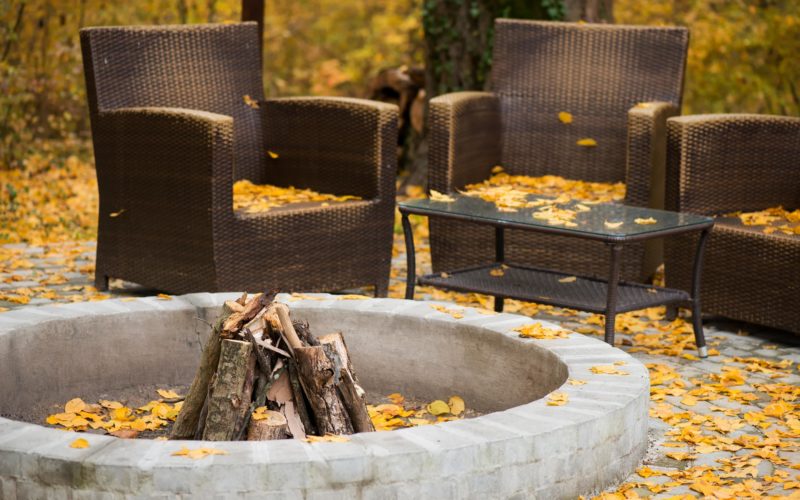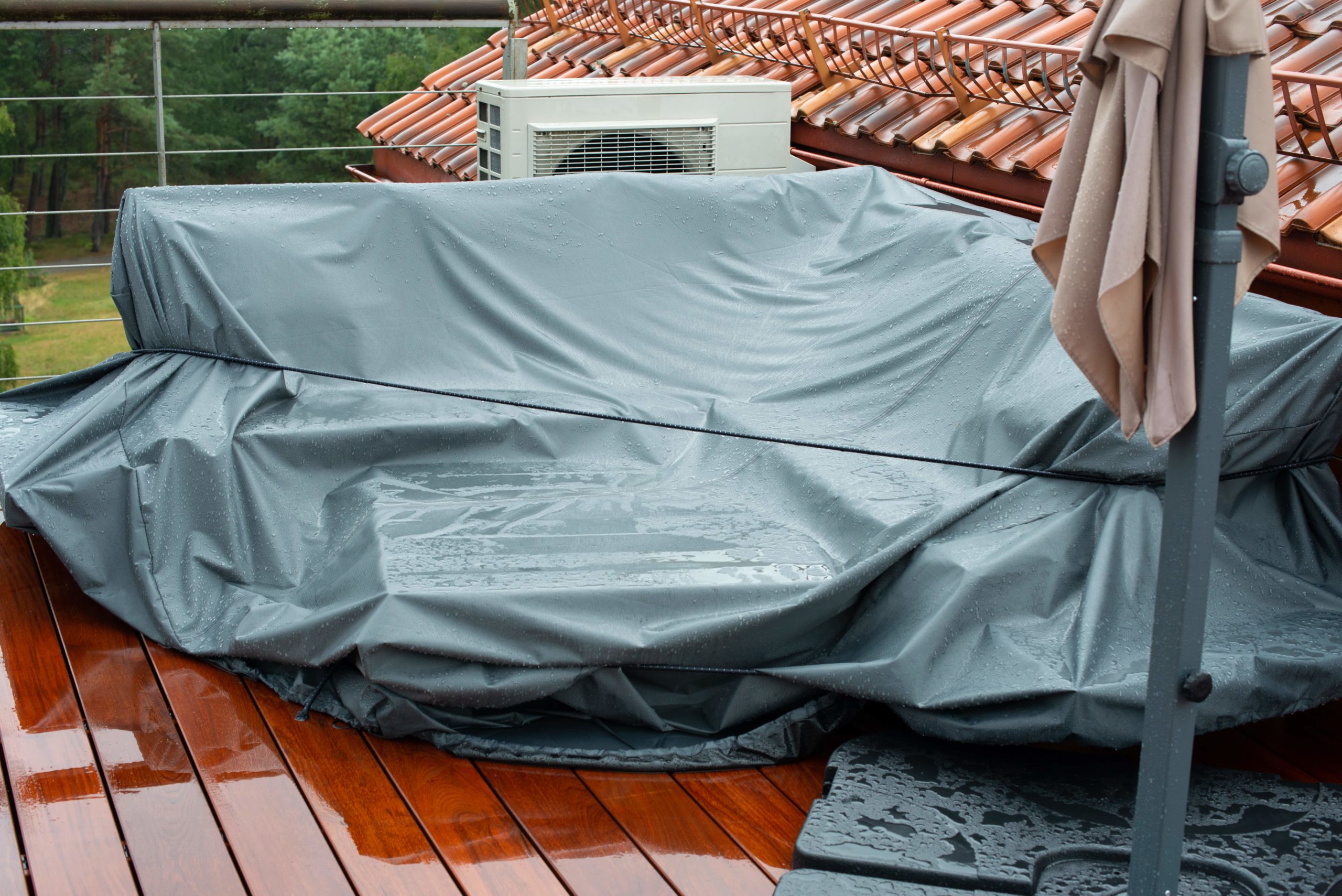A Homeowner’s Guide On How To Winterize Patio Furniture

Once again, winter is approaching, and with it comes new chores for your outdoor space. Before you begin decorating for the holiday season, you have to put some work in to ensure your home is ready for the cold. This year, while you focus on winter landscaping and plant care, don’t forget to prepare your outdoor furniture too.
After reading this blog, you’ll know the ins and outs of how to winterize patio furniture so your pieces are ready when spring arrives.
How to Winterize Patio Furniture
Learning how to winterize patio furniture should be a priority for any homeowner who wants to keep their outdoor space in excellent condition. So, as you begin working through your winter maintenance checklist this year, consider adding a few more tasks to the agenda.
Continue reading our guide to discover the best ways you can ensure winter patio furniture protection this year.
Clean It
Before you jump into the different ways you can protect patio furniture, it’s important to know how to clean and prepare it for winterization. Cleaning your furniture is necessary if you want your pieces to stay in good condition. The cleaning process will differ slightly depending on what type of material the furniture is.
Plastic and synthetic rattan furniture pieces are two of the easiest materials to maintain. To clean these types of materials, all you need is an all-purpose cleaner and a sponge or damp cloth. Simply apply the cleaner to the furniture and then wipe it down. Make sure it’s completely dry before storing or covering it.
Metal furniture, such as wrought iron, stainless steel, or aluminum are all very durable pieces for your patio area. Cleaning these is fairly easy as well. First, add a quarter cup of mild dish soap to a gallon of warm water. Next, get a sponge or cleaning brush and gently scrub the surface. Since rust is the main culprit for damaging metal furniture, it’s important to thoroughly dry your pieces when the cleaning is done.
Wicker, teak, or other wood furniture pieces are appealing to many homeowners because of their natural aesthetic. However, these materials often require a bit more maintenance than the others.
Softwoods, like wicker, should be cleaned with a mild oil soap and a soft brush or sponge. Stay away from rough cleaning tools and power washers since these will likely scar or damage the wood. If you notice any grime or grit in between the weaves, try using a toothbrush to reach the smaller spaces. We recommend cleaning wicker pieces more frequently to reduce any build-up.
Harder woods, such as teak or ipe, can be cleaned with a weak solution of water and laundry detergent, and a soft brush or sponge. You may be tempted to use teak oil in your cleaning process, but we strongly discourage this since it can often lead to mildew buildup. As you’re cleaning wood furniture, try working with small sections at a time. Once you’ve cleaned one section, dry it thoroughly before moving on to the next.
Fabric cushions and pillows are often additions to patio furniture. If you need to clean these pieces we recommend first trying to consult the manufacturer in case there are any specific instructions. However, most likely you’ll be able to clean any fabric with dish soap and warm water. In some cases, you may even be able to remove the fabric covers and put them in your washing machine.
Seal It
Whenever you purchase patio furniture, you should always add a protectant or sealant before it’s exposed to sun, rain, or other outdoor conditions. There are a variety of protectants you can use for different materials.
If you have wood furniture, you should seal your pieces with a coat of polyurethane sealant. This will keep the wood looking fresh and new as well as bring out its natural color. You’ll want to make sure the polyurethane sealant has UV blockers that will protect it from the sun.
For metal or aluminum furniture, try using paste wax. If you notice your furniture is already rusting or corroding, remove the debris first. Then, apply a primer and a new coat of paint. Finally, you can add paste wax to keep your pieces safe from the sun. You may also want to consider using a rust neutralizer for metals like aluminum or wrought iron.
Plastic or synthetic rattan furniture should also be coated with an outdoor furniture protector. We recommend using 303 patio furniture protectant that will help prevent fading and cracking.
Fabric cushions and pillows can be sealed as well. Consider adding a water-repellent fabric protector to reduce staining from rain, sun, or other elements.
It’s important to note that while adding sealants and protectants is important, they aren’t strong enough to act alone as winter patio furniture protection. When researching how to winterize patio furniture, you’ll discover that storing or covering your furniture is also necessary in addition to applying a sealant.

Store It
The most effective way to ensure winter patio furniture protection is to store it somewhere safe and dry. There are a few types of patio furniture that can be left outside in the winter such as teak, aluminum, synthetic rattan, and treated wood furniture.
However, if you’re dealing with other materials, you’ll want to consider finding somewhere to keep it away from the cold weather. The best way to store patio furniture is to find an area that’s clean, dry, and secure. This means garages, sheds, or even a basement are probably your best choice.
If you find your storage areas are limited in space, try stacking the furniture to utilize the most space. If stacking it won’t leave enough room for you to properly store everything, you can even consider renting a storage unit.
Oftentimes, patio furniture comes with cushions. If you’re wondering where to store outdoor cushions during the winter, you can simply keep them with your stored furniture.
However, if this happens to be in a garage, shed, or basement, we recommend you place your cushions in a secure storage bin or another type of container that will keep them from being damaged by moisture, dust, debris, or small animals/pests.
Cover It
Another easy option to consider when thinking about how to winterize patio furniture is covering it. Some homeowners won’t have extra storage space and they don’t want to spend extra money on a storage unit. This is when purchasing patio furniture covers can come in handy.
There are numerous furniture cover options available depending on the size of your pieces. While you may not like having to spend money on purchasing a cover, think of it as an investment. You can even use patio furniture covers when the weather is warmer and there’s heavy rain to keep the moisture out.
If you don’t want to buy an expensive cover, you can even use waterproof tarps. These work just as well and are significantly cheaper. However, when you use tarps, we recommend tying or weighing down the bottom of the tarps to limit as much exposure to the winter elements as possible.

Remember, your outdoor pieces were an investment meant to spruce up your outdoor space. Therefore, learning how to winterize patio furniture is the best way to guarantee the pieces continue looking brand new and in good condition.
Don’t wait to turn your patio space into a place everyone can enjoy. Browse our outdoor furniture collections today!
